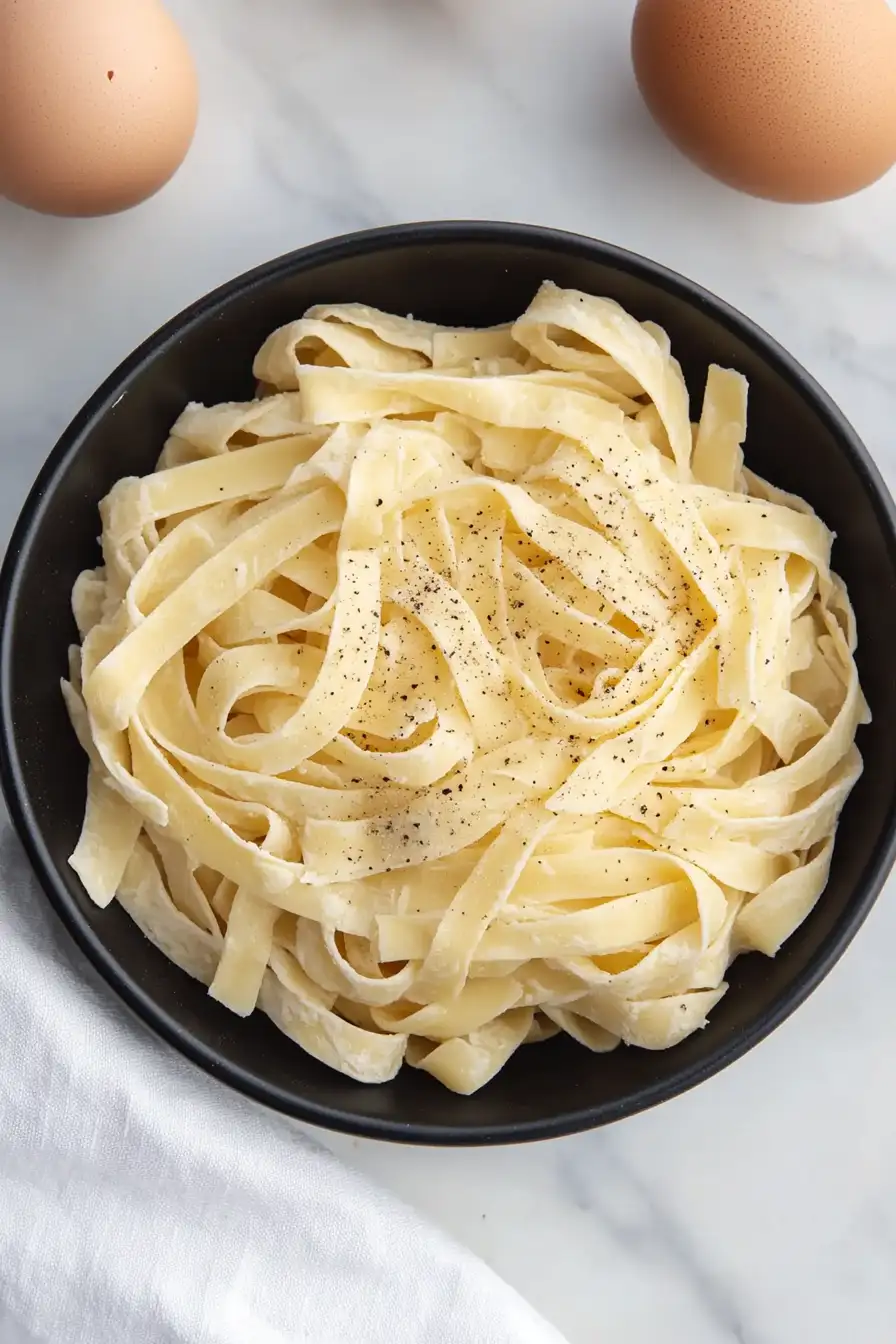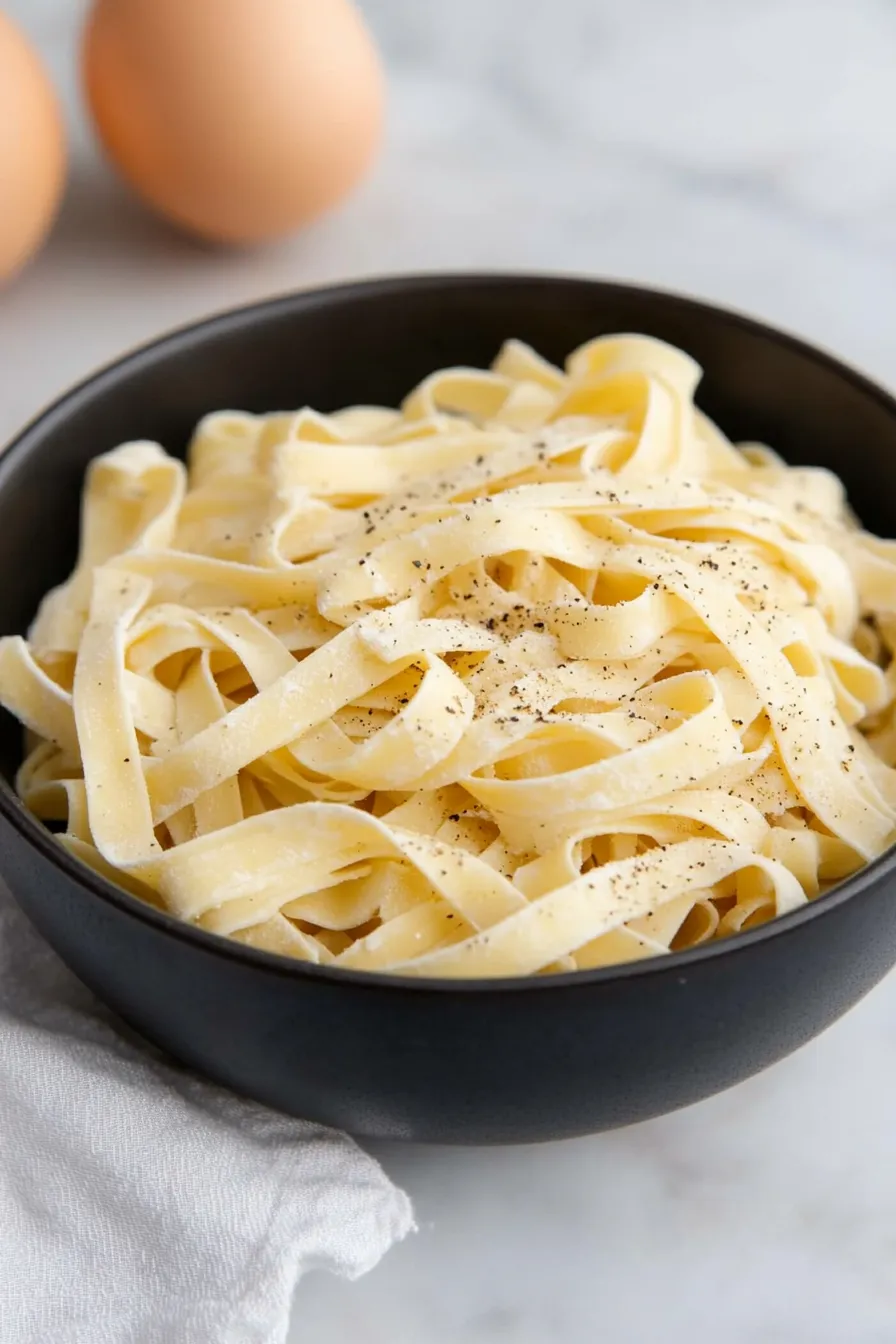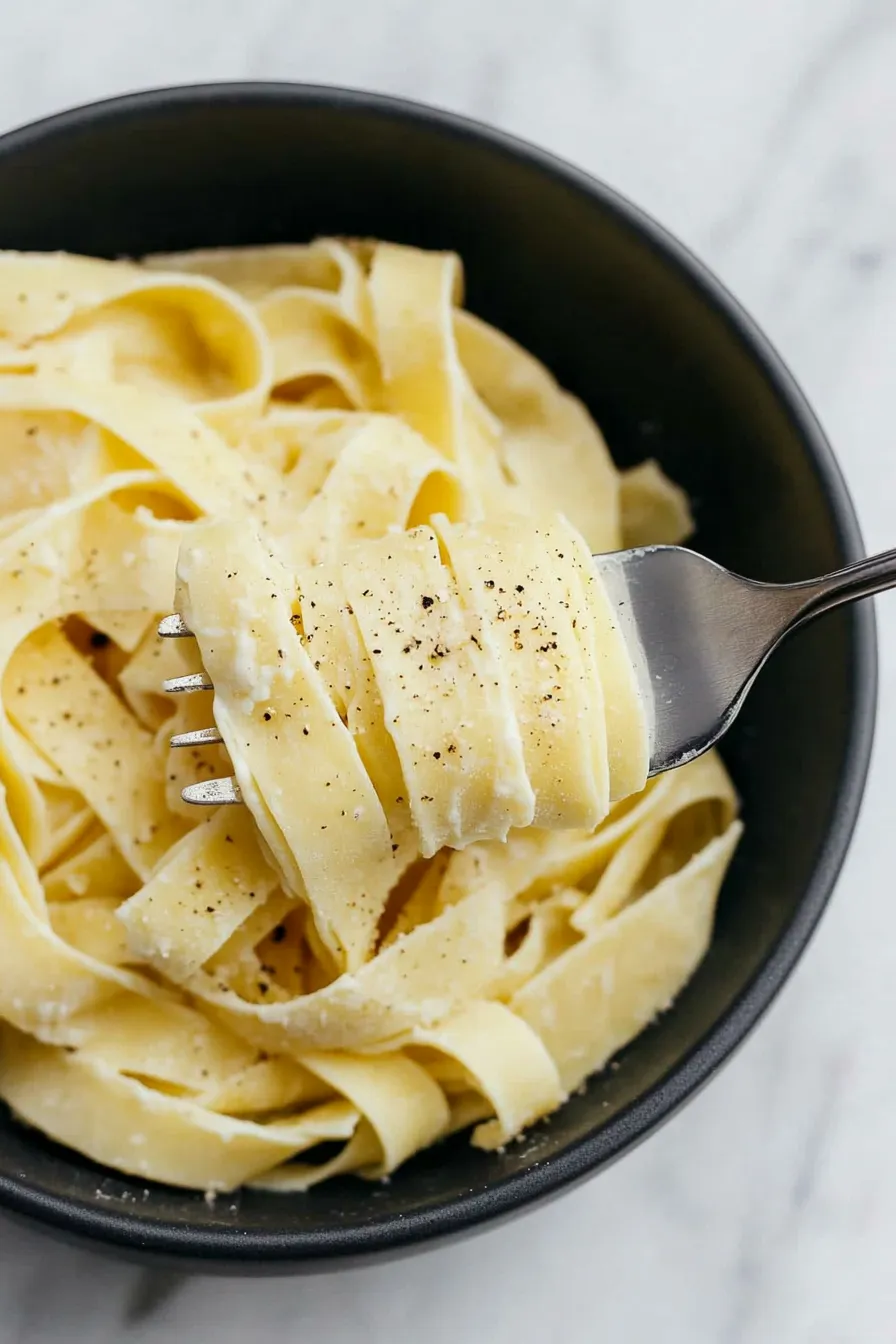Here is my go-to recipe for egg yolk pasta dough that makes wonderfully smooth, golden homemade pasta every single time. The recipe uses just a few basic ingredients – egg yolks, flour, olive oil, and a pinch of salt.
This pasta dough is what I turn to whenever I’m craving fresh pasta at home. I often make a double batch and freeze half for later, because once you try homemade pasta, it’s hard to go back to the store-bought kind.

Why You’ll Love This Egg Pasta Dough
- Rich, silky texture – The extra egg yolks in this recipe create a smooth, golden pasta dough that’s more tender than store-bought versions.
- Simple ingredients – You only need four basic ingredients that you probably already have in your kitchen – flour, eggs, egg yolks, and salt.
- Make-ahead friendly – The dough can be made in advance and stored in the fridge, perfect for planning your pasta-making around your schedule.
- Better than store-bought – Fresh homemade pasta has a texture and taste that puts dried pasta to shame, and you’ll know exactly what goes into your food.
- Cost-effective – Making pasta from scratch costs much less than buying fresh pasta from specialty stores, and you can make larger batches to freeze for later.
What Kind of Flour Should I Use?
While this recipe calls for all-purpose flour, you actually have a few good options when making pasta dough at home. All-purpose flour works great and it’s what most of us have in our pantries, but if you want to get really traditional, you might want to try “00” flour – that’s the super-fine Italian-style flour that many pasta makers swear by. Some folks also like to use semolina flour, either on its own or mixed with all-purpose flour, which gives the pasta a bit more bite and helps sauce cling better to the noodles. Just keep in mind that if you’re new to making pasta, starting with regular all-purpose flour is perfectly fine and will still give you great results.

Options for Substitutions
When it comes to pasta dough, some ingredients are essential while others can be switched up. Here’s what you need to know:
- All-purpose flour: You can use ’00’ flour (Italian-style flour) for a silkier texture, or substitute up to half the flour with semolina flour for a more traditional texture. Whole wheat flour can replace up to 1/3 of the all-purpose flour, but expect a denser result.
- Eggs and egg yolks: This is really the heart of the recipe – I don’t recommend substituting these as they’re crucial for the rich, yellow color and proper texture. If you absolutely must, you can use 4 whole eggs instead of the 2 eggs plus 4 yolks, but the dough won’t be as rich or golden.
- Kosher salt: Regular table salt works fine here – just use about 3/4 teaspoon instead of 1 teaspoon since table salt is denser than kosher salt.
- Note on measurements: For best results, stick to the weight measurements rather than cup measurements when making substitutions. This ensures your dough will have the right consistency.
Watch Out for These Mistakes While Making
The biggest challenge when making egg yolk pasta dough is incorrect hydration – too much flour makes the dough crumbly and impossible to roll, while too little creates a sticky mess that sticks to everything but itself. To find the sweet spot, add flour gradually and stop when the dough feels like a firm earlobe when pressed.
Another common mistake is rushing the kneading process – this dough needs a full 10 minutes of vigorous kneading to develop the gluten properly, which gives your pasta that perfect chewy texture. The dough should be smooth and spring back slightly when poked.
Skipping the resting period is a third crucial error – the dough needs at least 30 minutes (wrapped tightly in plastic) at room temperature to let the gluten relax, making it much easier to roll out without fighting back. If your pasta sheets keep shrinking while rolling, that’s a clear sign the dough hasn’t rested enough.

What to Serve With Fresh Pasta?
Fresh egg pasta is so good that you don’t need to go overboard with toppings – sometimes a drizzle of good olive oil and fresh parmesan is all you need! For a classic Italian meal, toss the pasta with a simple marinara sauce or brown butter and sage, which really lets the pasta’s rich, eggy flavor shine through. A light side salad with arugula and lemon dressing makes the perfect accompaniment, cutting through the richness of the pasta. If you’re feeling fancy, some garlic-roasted cherry tomatoes or sautéed mushrooms would be great additions to round out your meal.
Storage Instructions
Keep Fresh: Fresh pasta dough can rest in the fridge for up to 24 hours when wrapped tightly in plastic wrap. If you’ve already cut your pasta, dust it generously with flour, form it into little nests, and keep it in an airtight container in the fridge for up to 2 days.
Freeze: Want to save some for later? Shape your pasta and dust it well with flour, then form into nests. Place these on a baking sheet until frozen solid (about 1 hour), then transfer to a freezer bag. Your pasta will keep for up to 3 months – no need to thaw before cooking!
Make Ahead: This dough is perfect for making ahead! You can prepare it the day before and let it rest overnight in the fridge – some say this even improves the texture. Just remember to let it come to room temperature for about 30 minutes before rolling it out.
| Preparation Time | 30-45 minutes |
| Cooking Time | 2-5 minutes |
| Total Time | 32-50 minutes |
| Level of Difficulty | Medium |
Estimated Nutrition
Estimated nutrition for the whole recipe (without optional ingredients):
- Calories: 900-1000
- Protein: 30-35 g
- Fat: 25-30 g
- Carbohydrates: 130-150 g
Ingredients
- 2 large eggs
- 2 cups all-purpose flour (I always use King Arthur all-purpose flour for consistent results)
- 1 tsp kosher salt
- 4 large egg yolks (for a richer, more tender pasta)
Step 1: Make the Dough
On a large, clean work surface, pour your flour in a mound and create a well in the center about 4 inches wide.
Into the well, add whole eggs, egg yolks, and salt.
Using a fork, beat these ingredients together thoroughly.
Gradually incorporate flour into the eggs to form a wet, sticky dough.
Use a bench knife to scrape excess dough from the fork and your fingers.
Begin folding additional flour into the dough with the bench knife, turning it roughly 45 degrees each time, until the dough feels firm and dry, forming a craggy-looking ball.
This process should take about 2 to 5 minutes.
Step 2: Knead and Rest the Dough
Press the heel of your hand into the ball of dough, pushing forward and down.
Rotate the dough 45 degrees and repeat.
Continue kneading this way until the dough has a smooth, elastic texture similar to a firm ball of Play-Doh.
If the dough is too wet, add flour in 1 teaspoon increments.
If too dry, add water slowly using a spray bottle.
Once ready, wrap the dough tightly in plastic wrap and let it rest on the countertop for 30 minutes.
Step 3: Roll the Pasta
While the dough rests, place a sheet of parchment paper on a tray or cutting board and dust lightly with flour.
After resting, unwrap the dough and cut it into quarters.
Set one quarter on your work surface and re-wrap the remaining dough to keep it moist.
Use a rolling pin to flatten the dough quarter into an oblong shape about 1/2 inch thick.
Set your pasta maker to its widest setting and pass the dough through it 3 times.
Step 4: Thin the Dough
Lay the dough on a lightly floured work surface.
Fold both ends inward to meet at the center, then fold the dough again in half, aligning the end points, trying not to trap air inside.
Flatten with a rolling pin to 1/2-inch thick and pass through the pasta rollers 3 additional times at the current setting.
Gradually narrow the setting by 1 notch and repeat the rolling process, lowering the thickness with each pass until you achieve the desired thinness.
At this point, the dough should be delicate, elastic, and slightly translucent.
Step 5: Prepare the Rolled Dough
Place the rolled dough on a surface or baking sheet that is lightly dusted with flour or lined with parchment paper.
Fold the dough as needed to fit, adding more flour or parchment between layers to prevent sticking.
Cover with plastic wrap or a kitchen towel to keep it from drying out.
Repeat the rolling process with the remaining dough quarters.
If you plan to make noodles, cut the dough into 12- to 14-inch segments.
Step 6: Cut the Noodles
Adjust your pasta machine to the desired noodle setting.
Work with one dough segment at a time, passing it through the pasta-cutter.
Alternatively, use a chef’s knife to cut the folded dough by hand to your preferred noodle width.
Divide the noodles into individual portions, dust lightly with flour, and curl them into nests.
Place these on a parchment-lined baking sheet and cover gently with a kitchen towel until you’re ready to cook.
If you wish to store the pasta, freeze it directly on the sheet, then transfer to a zipper-lock freezer bag for up to 3 weeks.
Cook frozen pasta directly from the freezer.
Step 7: Cook the Pasta
To cook the pasta, bring a large pot of salted water to a rolling boil.
Add the pasta, gently stirring with a wooden spoon, chopsticks, or a cooking fork.
Cook, tasting at regular intervals, until the noodles are just set with a distinct bite, about 1 1/2 to 2 minutes.
Drain the pasta, toss with your preferred sauce, and serve immediately.

